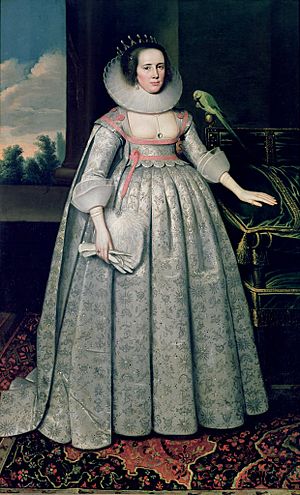Catherine Howard, Countess of Suffolk facts for kids
Katherine Howard, Countess of Suffolk (born Knyvet/Knyvett; 1564–1638) was an important English lady who worked for Queen Anne of Denmark.
Early Life and Family
Katherine Knyvet was born in 1564 at Charlton Park, Wiltshire. She was the oldest child of Sir Henry Knyvet and Elizabeth Stumpe. Her uncle was Sir Thomas Knyvet, who helped stop the famous "Gunpowder Plot".
Katherine first married Richard Rich. He was the son of Robert Rich, 2nd Baron Rich. After Richard died in 1580, she married Sir Thomas Howard. Twenty years later, he became the Earl of Suffolk.
When her father died in 1598, Katherine inherited Charlton Park, Wiltshire. This beautiful estate then became the main home for the Earls of Suffolk.
Life at Court
Katherine Howard became a lady-in-waiting to Queen Elizabeth I in 1599. She also became the Keeper of the Jewels. This meant she was in charge of the Queen's valuable jewelry.
When King James I came to power, Katherine continued her important roles. In 1603, King James sent her to meet his wife, Anne of Denmark. Katherine brought some of Queen Elizabeth's jewels from the Tower of London for Anne. Katherine then became a lady of the drawing room for Queen Anne. She also kept Queen Anne's jewels until 1608.
Katherine danced in two of Queen Anne's special plays called masques. One of these was written by the famous writer Ben Jonson. It was called The Masque of Blackness.
In 1606, Katherine was given charge of the rooms at Greenwich Palace. This was where Queen Anne gave birth to Princess Sophia. Katherine was so respected at court that she would have been a godmother to the princess if the baby had lived.
Challenges and Later Life
Katherine Howard worked hard to gain a high position at court. However, she was known for using her power to gain money unfairly. She acted as a go-between for Spain and the Earl of Salisbury. She asked for money to do this. When her husband, Thomas Howard, became the Lord Treasurer, she had even more chances to gain money.
In 1619, when she was 55 years old, Katherine became very ill with smallpox. This illness changed her appearance. A person named Lady Anne Clifford wrote that it "spoiled that good face of hers."
Later that same year, Katherine and her family faced problems because of how she handled money. She and her family were no longer allowed at court. Many people felt sorry for her husband, the Earl, believing he was caught up in her actions. Katherine received most of the blame for their fall from grace. Even after being expelled from court, she continued to write letters to help others get court positions.
Descendants
- Theophilus Howard, 2nd Earl of Suffolk (1582–1640); married Elizabeth Hume
- Elizabeth Howard (c. 1583–1658); married first William Knollys, 1st Earl of Banbury, then Edward Vaux, 4th Baron Vaux of Harrowden
- Sir Robert Howard (1598–1653); married Catherine Nevill
- Sir William Howard (1586–before 1672)
- Thomas Howard, 1st Earl of Berkshire (1587–1669); married Elizabeth Cecil. He inherited the Wiltshire estates (Charlton Park) that had passed to his mother.
- Catherine Howard (c. 1588–1673); married William Cecil, 2nd Earl of Salisbury
- Frances Howard (1590–1632); married first Robert Devereux, 3rd Earl of Essex then Robert Carr, 1st Earl of Somerset
- Sir Charles Howard (1591–1626); married Mary Fitzjohn
- Henry Howard (1592–1616); married Elizabeth Bassett
- Edward Howard, 1st Baron Howard of Escrick (died 1675)
- Margaret Howard (c. 1599 – 1608)




